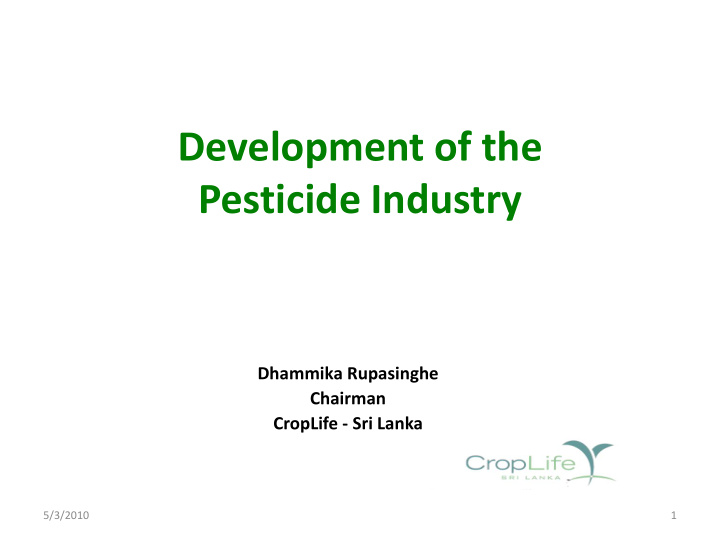



Development of the Pesticide Industry Dhammika Rupasinghe Chairman CropLife - Sri Lanka 5/3/2010 1
Green Revolution 1950 - Scientists introduced improved varieties, synthetic fertilizers, pesticides & irrigation methods. To increase the world food production 5/3/2010 2
Pesticides • A pesticide is any natural or man-made substance used to control unwanted pests (insects, weeds, fungi, etc..) • Usage of pesticides – crop protection to increase yield and control pests – to protect your home, lawn and landscapes (termites, grubs, beetles, poison ivy, etc..) – hygiene and public health (cock roaches, fire ants, mosquitoes, fleas, ticks, rodents, etc..) – animal health (fleas, ticks, flies, etc..) • Innovation in pesticide development is focused on maximizing potential benefits and minimize potential risks. 5/3/2010 3
One hectare (2.5 acres) of arable land must feed a rising number of people (Amount of arable land is constant at approximately 1.5 bn ha) 1.7 / ha 4.0 / ha 7.0 / ha 12.5 10.3 7.5 6.0 2.5 2.5 1950 2000 2050 The world population is constantly increasing 5/3/2010 4
50% of harvest lost without Crop Protection Average Destruction of non-treated Crops out of total attainable Production 60 Yield losses in % 50 post-harvest losses 10 % 40 13 % fungal pathogens 30 14 % weeds pre-harvest losses 20 10 15 % insects 0 Major crops analyzed: Rice, wheat, barley, corn, potatoes, soybeans, cotton and coffee* * approx. 50 % of crop area worldwide Source: Oerke et al., 1995 / Yudelman et al., 1998 5/3/2010 5
Agricultural Area Required to Produce Global Food Supply With & Without Crop Protection “Greater Demands on Theoretical Potential Arable Land with and Earth's Surface Area: 13 bn ha without Crop Protection” Year 2025 World Population: Status Quo / Year 2000 4.3 bn ha 8.0 bn People World Population: Desert, 33% Glaciers, 6.0 bn People 5.9 bn ha Mountains without Crop Protection 3.8 bn ha 4.0 bn ha 29% Forest, without Steppe Crop Protection 1.5 bn ha 3.4 bn ha with 26% Grassland, Crop Protection Prairie 1.5 bn ha 12% Arable land 1 Hectare (ha) = 10 000 m 2 Source: D.T. Avery, US-Hudson Institute - FAO
Research & Development in Crop Protection Chemistry Average rate of new product introduction Products 14 per Year 12 10 8 6 4 2 0 1950s 1960s 1970s 1980s 1990s 2000s 5/3/2010 7 Source: Phillips McDougall
Research & Development in Crop Protection Chemistry Products introduced since 1980 by type = 286 Others 3.8% Herbicides 43.4% Fungicides 28.3% Insecticides 24.5% 5/3/2010 8 Source: Phillips McDougall
Research and Development Plant Science Industry - A Research-Intensive Sector 14 R&D % of Sales by Sector 12 10 % Sales 8 6 4 2 0 5/3/2010 9 Source: Financial Times
Discovery and Development Cost of a New Crop Protection Product Category Sub Category Cost (Euro m.) Research Chemistry 44 Biology 48 10 toxicology/Environmental Research total 102 Chemistry Development Chemistry 22 Field Trials 27 Toxicology 20 Environmental Chemistry 17 Developmental total 86 Registration 12 Total 200 Source: Phillips McDougall 5/3/2010 10
Important Product properties 1. Physico – Chemical Properties of Active Ingredient /Technical / Formulation 2. Product fate in the environment – Soil , water, crops 3. Toxicological Impact of Pesticide on Biological Systems - Effect on Beneficial insects, Bees , Aquatic Organisms ( fish, algae), Earth worms, Birds etc., 4. Toxicological Test Reports on a) Acute Toxicity (oral, dermal, inhalation, eye) b) Sub Chronic & Long Term Toxicity (Mutagenecity , Oncogenecity , Reproductive Toxicity, Teratogenecity) c) Acceptable Daily Intake (ADI) No Observable Effect Level (NOEL) Maximum Residue Level (MRL) 5/3/2010 11
R&D in Crop Protection Chemistry Output Better chemicals with improved safety profile Better formulations with reduced risk Better packaging and improved container management Application technology 5/3/2010 12
Better chemicals with improved safety profile Target Specific pesticides - Low application rates - - Insect growth Regulators (IGR) (Chitin Synthesis Inhibitors) - Moult Accelerating Compounds (MAC) 5/3/2010 13
Better formulations with reduced risk • Less toxic • Slow release Eg. Micro Encapsulated formulations • Unattractive granules • Soil incorporated 5/3/2010 14
WHO Classification of pesticides LD50 for rats (mg/kg body weight) Oral Dermal Classification Class Solids Liquids Solids Liquids Extremely I a 5 or less 20 or 10 or less 40 or less hazardous less Highly I b 5-50 20-200 10-100 40-400 hazardous Moderately II 50-500 200- 100-1000 400-4000 hazardous 2000 Slightly III Over Over Over Over 4000 hazardous 500 2000 1000 Unlike to present Over Over Acute Hazardsof IV 2000 3000 pesticides 5/3/2010 15
Better packaging and improved container management ISO certification for repackaging - (ISO 9001 , ISO 14001 certification) Use of HDPE & PET bottles - - Pesticide labels 5/3/2010 16
Pesticide industry in Sri Lanka Regulation by Pesticides Act No.33 of 1980 Control of Pesticides (Amendment) Act No.06 of 1994 Authorized person Registrar of Pesticides Office of the Registrar of Pesticides Only Registered products at the office of the Registrar of Pesticides can be marketed in Sri Lanka 5/3/2010 17
Introduction of a new pesticide to Sri Lanka Pre registration Evaluation Registrar of Pesticides Sample Approval for testing Bio efficacy testing at Research Stations Department of Agriculture Recommendation from Dept. of Agriculture Submission of Registration Pesticides Registrant Dossier Registration & Approval for Marketing Registrar of Pesticides Re-registration after 3 years 5/3/2010 18
Import of pesticides Submission of Quality Registrar Registrar certificate of Import of Import of & samples pesticides’ Approved Controller Pesticides to approval to volume approval Registrar market the • Import Licence of product Pesticides 5/3/2010 19
Contribution on Sustainable Development 1. Research and Development 2. Technology Transfer and Extension 3. Stewardship, Education and Training 5/3/2010 20
Thank you. 5/3/2010 21
Recommend
More recommend